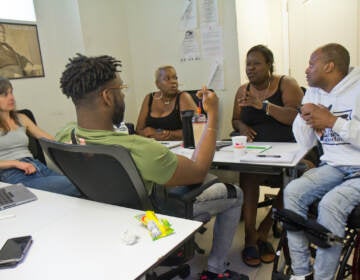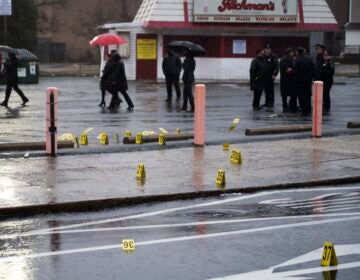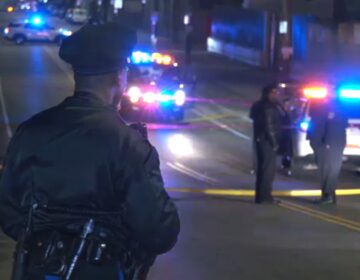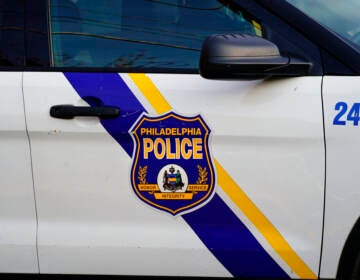Philly police believe more officers could prevent an escalation of violence this summer. Advocates say the problem runs deeper
Philadelphia police say they need more help, but they’ll be more proactive about traffic control this summer.
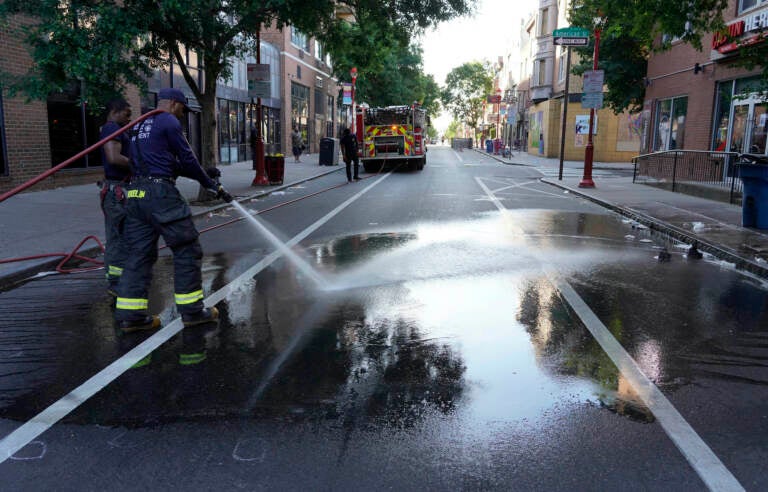
A Philadelphia firefighter washes blood off the sidewalk at the scene of a fatal overnight shooting on South Street in Philadelphia, Sunday, June 5, 2022. (AP Photo/Michael Perez)
Video footage from South Street last Saturday night has been surfacing on social media — providing snippets of the frenzied evening that led up to a mass shooting in a packed section of Philadelphia.
In the moments before the shooting, three men were brawling on a sidewalk in front of Rita’s Italian Ice. A disturbing video captures the lead-up to the gunshots and the prolonged screaming of bystanders.
A different clip from another part of the evening shows a group of teens throwing jabs, occasionally jostling the nearby crowd. That altercation, which has not been tied to the shooting, happens within eyesight of a police vehicle.
In the aftermath, many Philadelphians are asking versions of the same question: Should police have taken more action to manage the crowd?
”If police officers are trying not to blindly arrest everyone and just diffuse the situation, that’s a fair tactic,” said Anthony Erace, interim executive director of the Philadelphia Citizens Police Oversight Commission, in defense of officers staying on the sidelines. “In this case, it didn’t work.”
Philadelphia saw a record number of fatal shootings in 2021, and the tally is nearing 200 this year. People trying to address the crisis say the scene on Saturday wasn’t out of the ordinary.
“South Street is a spot where the Black community has always come to … it’s like a party,” said Ant Brown, a Philly native, youth mentor and musical artist.
He says there are often fights there, usually between young people with beefs that have been passed on from older family members and peers.
“The lack of security, the lack of police presence could be a reason that people were acting a little bit extra and everything,” he said.
But shoot-outs happen almost daily in neighborhoods outside Center City, Brown pointed out, and preventing violence has a lot more to do with addressing young peoples’ trauma and anger than it does with the police.
“I don’t think anything could have happened to stop what happened at South Street that particular night,” he said. “This is a multi-generational problem that we have.”
Students at Furness High School in South Philadelphia said the brawling that happened on South Street before the incident is related to the culture of violence among their peers.
“Seeing the news, I wasn’t very surprised,” said Sheilliam, 16. “I’ve been in situations like that, when I saw people right in front of me fighting … with weapons.”
They said fighting can easily escalate to shootings if parties involved aren’t willing to work it out peacefully.
“Nowadays with teenagers, mental health is pretty bad, you know, so they’re just really easily irritated by others,” said Sylvain, 15. “So they’re like emotional, so they fight each other.”
“When people start throwing punches, you can’t really end it unless you get yourself hurt,” said Kim, 16. “That’s usually how it is.”
There are some programs in Philadelphia that teach teens how to be their own mediators and resolve conflicts before they lead to violence.
But when fights do break out — especially in an already chaotic environment — police officers may be the first or only ones able to respond.
Police watch groups and strategy experts say there were steps that the Philadelphia Police Department could have taken in advance of Saturday to make it more difficult for such a large crowd to gather.
The PPD did not immediately provide comment on their strategy Saturday night. In light of the incident, they’ve stated that they will put certain traffic control measures and closures in place in areas of the city that could draw crowds, and they’ll increase officer presence at large events.
PPD Commissioner Danielle Outlaw said at a Sunday press conference that she is in need of more resources, and that the force is stretched thin addressing shootings and other quality of life issues throughout the city. The department is facing a workforce shortage, and there have been calls at the city and state levels to hire more officers.
At the same time, many Philadelphians have criticized the notion that more police is the answer. Some research suggests that it’s not effective in reducing gun crime.
At the beginning of what activists and law enforcement fear will be a violent summer, and with multiple large events on the horizon, some Philadelphians are calling for a coordinated approach to the factors driving the crisis. There’s also a push for the Philadelphia Police Department to take a more active role and follow best practices, such as crowd control and conflict de-escalation, to keep the streets safe.
‘Keep that crowd moving’
Whether the police decide to intervene in any physical altercation depends on several factors, law enforcement sources say. These include the number of officers on site compared to attendees, whether attendees are armed, and whether bystanders are in danger.
“People made decisions based on the information they had at the time and not the information that we now have on Monday morning,” said Joe Sullivan, who served the Philadelphia Police Department for more than three decades before leaving his post as deputy commissioner in 2020. “But we definitely have to use a different tactic going forward.”
Those tactics, per Sullivan, could include:
- maintaining steady car traffic on South Street between Broad and 2nd streets
- keeping the parking lanes filled with parked cars and putting police officers in each section
- adding police vehicles or bicycles as necessary
- having a high-ranking officer onsite to give clear instruction
“You instruct those officers [that] their basic function is to make sure there are no fights, no disturbances, and to keep that crowd moving,” Sullivan said.
He added that right now there’s “a lot of ambiguity within the rank and file of the department,” and said he thought the officers on site Saturday night were outnumbered and taken by surprise.
“If you have officers pre-positioned and obviously organized, well supervised, well briefed — they understand their mission, they understand what is expected of them,” he said.
The International Association of Chiefs of Police recommendations on crowd control suggest thorough briefing for officers in situations that have the potential to become violent. That involves guidance on minimizing physical contact with crowds, maintaining a “courteous and neutral” demeanor, avoiding mass arrests, and working with local businesses and community partners to establish safety plans.
There is a crucial window of time when officers should be scoping the scene and using body cameras, drones, or other methods of intel to check in with each other, said Thaddeus Johnson, assistant professor of criminal justice and criminology at Georgia State University.
“You can feel the energy of the crowd. You can tell by certain events,” he said. “Once these things pop off, it seems to go downhill and all you’re trying to do is simply separate people.”
Johnson was a ranking law enforcement officer in Memphis before entering the academic sphere. He’s now a research fellow at the Council on Criminal Justice, a nonpartisan organization promoting a “fair and effective” justice system.
He says in his years on the force, he often worked the busy nightlife scene on Beale Street downtown. He emphasized the need to have officers patrolling on foot and bike, to keep a commanding officer on scene, to create perimeters where necessary, and to ensure that there are routes for first responders to enter if needed.
“We barricaded alleyways, those entry points that people try to sneak onto the streets … sneak weapons, sneak contraband into the area,” he said. “We didn’t have officers out there making arrests … it has to be coordinated.”
‘A very dangerous place’
The question of how to manage a crowd and when to break up a physical altercation has become especially fraught in the years since the George Floyd demonstrations, and there’s a heightened concern around use-of-force protocols.
Former PPD deputy commissioner Sullivan said the dramatic increase in guns on the street has affected this kind of decision-making.
“Every encounter between police and citizens has the potential to escalate into violence,” he said. “It is a very contentious atmosphere and a very dangerous time to be a police officer and, unfortunately, a dangerous time to be a member of the public.”
The International Association of Chiefs of Police guidelines do state use of force can be used if crowds don’t heed verbal warnings, with options including multiple simultaneous arrests and the use of chemical agents and batons to force crowd movement
Criminologist Thaddeus Johnson said those more aggressive moves risk a riot. He said officers in Memphis found a way to walk that line of maintaining order without escalating the situation. The City of Memphis has been upfront about its police reform efforts.
“It wasn’t like you have officers walking around patting people down,” he said. “Like, if you see a group of juveniles … Don’t go up confrontational. Go up and speak to them. Engage them … And if they don’t comply, then you go up. That continuum of force, what have you, in order to get the job accomplished.”
Deescalation training can help officers learn this approach, Johnson said, but it hasn’t been widely adopted. According to a 2021 report from the Council on Criminal Justice, this education teaches officers how to remain calm, communicate well and “employ critical thinking skills to pivot to other tactics in response to changing dynamics.”
Only 16 states require de-escalation training as of 2017, according to the report. A review of the nation’s 100 largest agencies found that as of early February 2021, 56 required officers to employ de-escalation techniques before using force. The Philadelphia Police Department does have some de-escalation education in place.
There are mixed views in Philadelphia’s Black communities about whether an expanded or more active police presence would reduce gun crime, with many believing a state of lawlessness has allowed violence to thrive. Others feel the city already spends too much on law enforcement and not enough on social services that could direct shooters or potential shooters onto healthier life paths.
“At the end of the day, the police can only do so much because the community don’t respect them,” gun violence prevention advocate Ant Brown said.
Instead, Brown is calling on the City of Philadelphia to create a state of emergency around gun violence, a move that Mayor Jim Kenney declined to make in 2021. He also wants to see improvements to the educational system, better access to mental health care for kids coping with gun violence, and more support for parents in trauma-affected households.
“We wasn’t raised and groomed for how to handle situations, so we handle them with anger and frustration,” he said. “Arresting somebody is not the answer. I’m not saying that nobody should be locked up. I’m just saying let’s put together a plan that starts healing a wound instead of just patching it up and throwing on a band-aid.”
Akayla Brown, the 19-year-old founder of youth nonprofit Dimplez 4 Dayz, said it all comes down to convincing teens that they don’t need to be involved in violence just because their peers are. And afterschool programs that promote self-worth are a big part of that.
“If you make it clear to youth that that’s not it, they’ll start passing the message,” she said. “Right now this generation, because of all the music and the rappers, the cool thing is to have a gun, unfortunately.”
If you or someone you know has been affected by gun violence in Philadelphia, you can find grief support and resources here.
WHYY is your source for fact-based, in-depth journalism and information. As a nonprofit organization, we rely on financial support from readers like you. Please give today.


